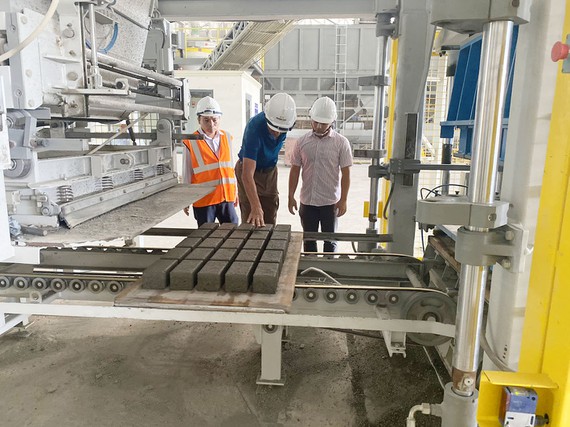It is necessary to improve mechanisms and policies to develop unburnt materials
The development of unburnt materials (VLKN) contributes to reducing CO2 emissions from small craft brick factories, fly ash from thermal power plants, and saving resources of clay, coal… However, after 10 years of implementing the Government’s Project 567 on the use of natural materials, the results have not been as expected. The inevitable development trend
Statistics show that the construction materials industry currently has about 2,500 enterprises, ensuring about 30% of the demand for the building materials industry. VLKN was born with preeminent features in construction design, making full use of redundant by-products in exploitation and production, contributing to reducing environmental pollution, minimizing greenhouse gas emissions. , save fuel coal, oil, gas, electricity.
Mr. Tran Phuong Dong, Director of Bach Viet Building Materials Joint Stock Company, said that it is very clear that the widespread use of fired bricks, causing loss of agricultural land and polluting the environment cannot last forever. Okay. Although there are still some backlogs, with the benefits that VLKN brings to the environment and society, the development of VLKN is considered a “golden key” in the current context. With the desire to meet the Government’s policy on sustainable economic development, the Company has invested in an unburnt brick factory in Vinh Cuu district (Dong Nai), with Germany’s production lines and technology. the capacity of 20 million tablets/year.

Following this trend, Hoang Son Fly Ash and Cement Joint Stock Company (South branch – Long Hau Industrial Park, Long An province) has also invested in building an unburnt brick factory with a capacity of 77 million bricks/year. using vibration pressing technology that does not emit CO2 into the environment and thoroughly applying waste products from thermal power plants. The company also invested in a fly ash treatment plant with Christian Pfeiffer technology (Germany) in Long An, contributing to improving air quality from Vinh Tan and Duyen Hai thermal power plant clusters. In 2015, Hoang Son Company was a pioneer in bringing fly ash to Ho Chi Minh City for application in the process of concrete production and cement grinding. Today, this is an indispensable additive in fresh concrete stations, unburnt brick factories, and cement grinding stations.
There are still difficulties
According to Mr. Hoang Minh Truyen, Deputy Director of Hoang Son Fly Ash and Cement Joint Stock Company, the development of VLKN currently faces many difficulties. The reason is that most people do not have the habit of using unburnt bricks while the economic competitiveness of this product is not high compared to handmade clay bricks. Although the Government has issued many regulations on encouraging the production of unburnt bricks and abolishing manual brick kilns, localities have not really implemented them thoroughly, so encouraging the use of this product is still difficult. .
Circular 09 dated November 28, 2012 of the Ministry of Construction on regulations on the use of non-woven materials for construction works requiring that in urban areas of grade 3 or higher, 100% of non-woven materials must be used from the effective date of the circular. ; the remaining areas must use at least 50% (before 2015) and must use 100% after 2025. But so far, the number of private works using adobe bricks is still very limited. It is thought that relevant ministries and sectors should direct more drastically and provide long-term oriented strategies for the production of materials.
Sharing the same view, Mr. Tran Phuong Dong added that in February 2021, the Government issued Decree No. 09/2021 on management of construction materials to replace Decree 24a/2016 and Decree No. 95/2019. . However, the content on the management of production and use of VLKN is completely inconsistent with the Program 567 on the development of production and use of VLKN to replace terracotta bricks; as well as inconsistent with the Decision approving the Strategy for the development of building materials in Vietnam for the period of 2021 – 2030, with a vision to 2050.
Accordingly, the content of VLKN in Decree 09/2021 completely removes the incentives in production, production expansion, as well as the requirements for use in high-rise buildings suddenly, causing the businesses more difficult. Even this impact can cause bankruptcy of businesses that have been built for many years. A number of businesses have submitted petitions to the Prime Minister and the Ministry of Construction to propose a suitable solution.
In order to really encourage the production of non-woven materials, many people think that we need to perfect appropriate mechanisms and policies, with incentives in the production, exploitation and use of non-woven materials. At the same time, increase environmental tax on construction material production activities that cause environmental pollution. Promote research, master production technology, application of green and energy-saving materials in construction works. In parallel, it is a policy to encourage people to promote the use of non-woven materials and green materials.


